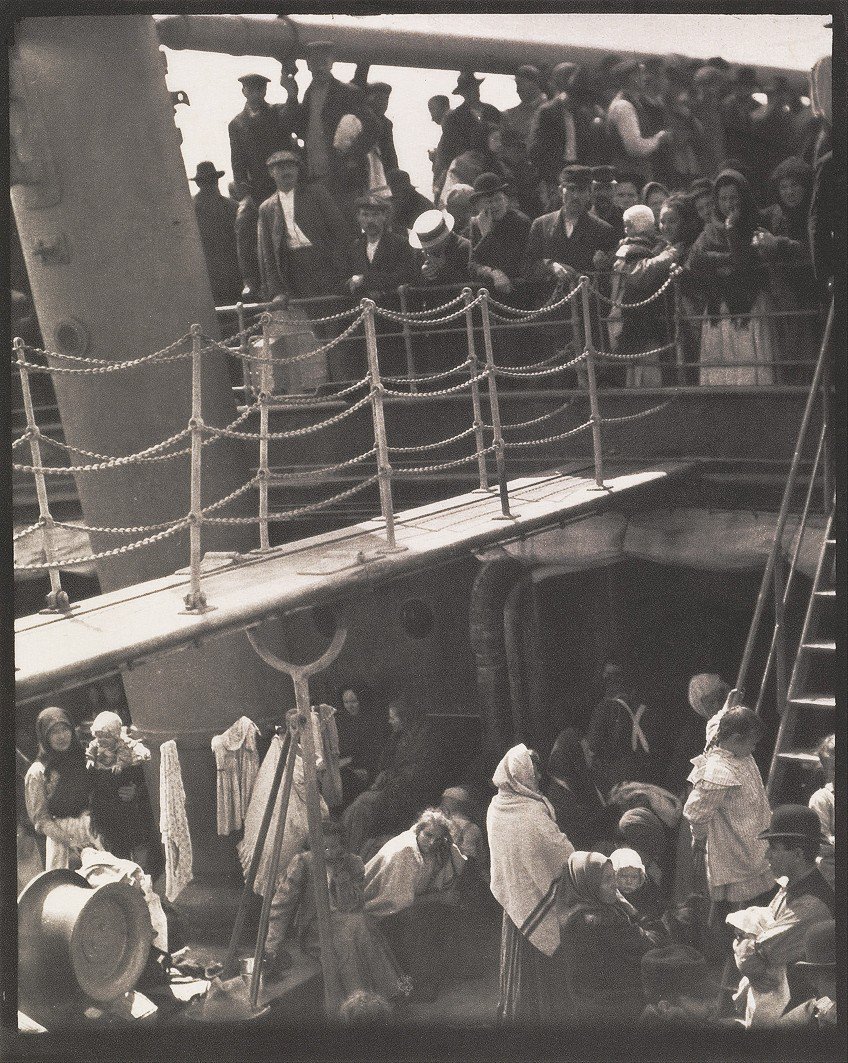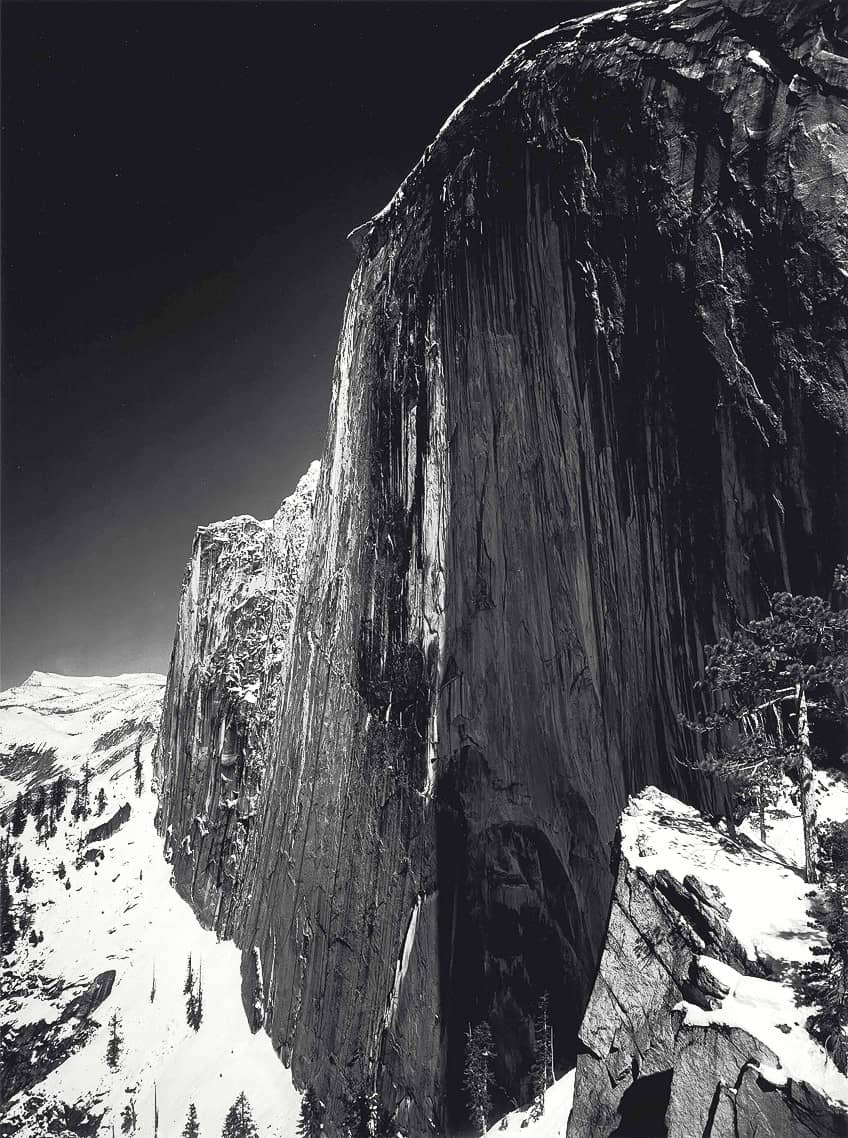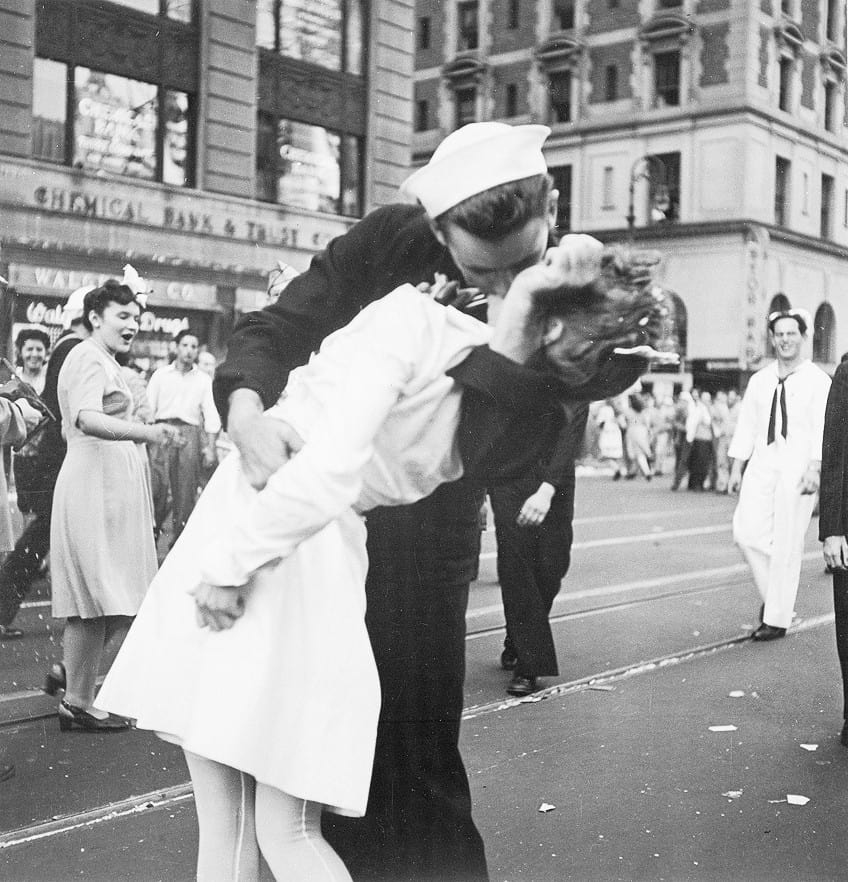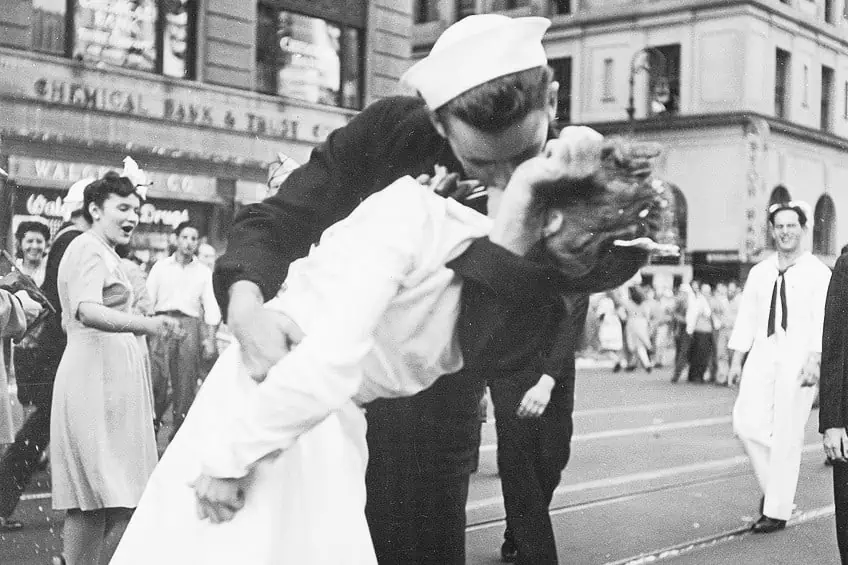Famous Black and White Photos – 15 Classic Photos in Grayscale
In today’s high-tech world, we are inundated with high-quality color photographs on a daily basis on social media. Yet, it all started with the iconic black-and-white pictures of the past. It did not end with historic black-and-white photos, though, and many modern photographers still love to work in this palette. Which famous black-and-white photos left the biggest mark on our history, though? Join us below, as we reveal the most iconic black-and-white pictures!
Discovering the Most Famous Black and White Photos
Without any color, black-and-white photographs allow the audience to instead focus on the composition and subject matter present. The interplay between light and shadows also becomes more prominent, creating scenes that appear more dramatic and textured. The absence of color also provides black-and-white photography with a timeless quality that seems to transcend different eras of our history, conveying a sense of nostalgia. Let us find out which iconic black-and-white pictures have remained influential and loved through the decades.
The Steerage (1907) by Alfred Stieglitz
| Artist Name | Alfred Stieglitz (1864 – 1946) |
| Date Taken | 1907 |
| Medium | Photogravure |
| Dimensions (cm) | 32 x 26 |
In 1907, Alfred Stieglitz captured what many regard to be the very first modernist photo while on vacation in Europe. It represents his abandonment of Symbolist subjects in favor of those of ordinary life – a depiction of steerage, the ship’s lowest-priced rooms. This photograph has been regularly used to depict the journey of immigrants traveling to the United States, yet it was actually taken as the ship was leaving the States for Germany.
The people coming onboard may have been foreigners whose working visas had expired and were returning back home. The photographer himself was traveling first class at the time this photo was taken.
 The Steerage (1907) by Alfred Stieglitz; Alfred Stieglitz, Public domain, via Wikimedia Commons
The Steerage (1907) by Alfred Stieglitz; Alfred Stieglitz, Public domain, via Wikimedia Commons
He only had a single plate on him and was concerned that it would not capture the scene as he saw it. The scene was full of interesting shapes and angles that appealed to his eye, and he felt that if he could capture all these aesthetically pleasing elements then the photo would be akin to fine art rather than just a photo. This is why this photo is not only regarded as a piece of visual documentation but also an early example of what would become modernist photography.
Cotton Mill Girl (1908) by Lewis Hine
| Artist Name | Lewis Hine (1874 – 1940) |
| Date Taken | 1908 |
| Medium | Gelatin silver print |
| Dimensions (cm) | 26 x 34 |
A little girl of about 12 years old is positioned between a cotton loom and a window that appears to stretch into the horizon behind her. Making young people work in different industries was still very prevalent at the turn of the previous century. Lewis Hine taught sociology until 1908. He became the National Child Labour Committee’s photographer after publishing various studies about work and life at the beginning of the 20th century.
His work included journalistic photography along with research, and he started out with a large-format camera in 1908, visiting various factories and mills.
Cotton Mill Girl (1908) by Lewis Hine; Lewis W. Hine, American, 1874–1940, Public domain, via Wikimedia Commons
Because photography was prohibited in most areas he visited, he had to sneak his camera in, which was rather difficult with a large-format camera. Sometimes he managed to get in by pretending to be a missionary selling Bibles and other times he would pretend to be an industrial designer who had come to document the machinery used. These images proved to be an important weapon in the fight against child labor and inhumane working conditions.
Monolith, the Face of Half Dome, Yosemite National Park (1927) by Ansel Adams
| Artist Name | Ansel Adams (1902 – 1984) |
| Date Taken | 1927 |
| Medium | Gelatin silver print |
| Dimensions (cm) | 49 x 36 |
This view of the Half Dome is rendered as a high-contrast photograph and is among Adams’s most famous black-and-white photos. It is less a portrayal of how the landscape appeared at that specific time and more of a dramatic representation of Adams’ feelings upon witnessing the scene portrayed in the photograph. Adams considered Yosemite’s huge rocks to be the most captivating formations of their kind, embodying elements of ageless, yet intimate grandeur.
Adams, impressed by the Yosemite panorama, sought to convey his own feelings about this incredible natural setting using his camera.

Adams took the shot from a granite slab suspended 3,500 feet over the valley floor. He had been looking for a perspective of the Half Dome that captured his sense of awe. He applied a dark red filter, which substantially darkened the sky and emphasized the half dome’s white snow and shining granite. The resulting shot constituted a turning point in his career: he had essentially previsualized what the image would look like before pressing the shutter release.
Lunch atop a Skyscraper (1932) by Charles C. Ebbets
| Artist Name | Charles C. Ebbets (1905 – 1978) |
| Date Taken | 1932 |
| Medium | Black and white photograph |
| Dimensions (cm) | Non stated |
This famous photo from 1932 portrays 11 construction workers taking a lunch break on a beam 69 stories off the ground. Many people think that it was taken on top of the Empire State Building, yet it was actually shot during the construction of the Rockefeller Center. The construction of this building received much public attention due to the sheer scale of the project as well as the impact that it would have on the economy.
This was the era of the Great Depression, so the fact that 250,000 local workers were employed for the project was a big deal. The pay was also said to be quite good, yet the job came with the very real risk of potentially losing your life.

These workers had no safety gear to stop them from falling off these beams that were often 100s of feet in the sky. Yet, this photo was seen as symbolic of the hope for recovery of a nation that was building itself back up during a time of financial difficulties. The men eating lunch at work also symbolized their ability to put food on the tables of their families.
Place de l’Europe Gare Saint Lazare (1932) by Henri Cartier-Bresson
| Artist Name | Henri Cartier-Bresson (1908 – 2004) |
| Date Taken | 1932 |
| Medium | Gelatin silver print |
| Dimensions (cm) | 44 x 29 |
This photograph of a man enthusiastically jumping across a flooded area in Paris depicts the exact moment the man’s heel contacts the water and is regarded as among the photographer’s most famous black and white photographs. The photo’s spontaneity, shot in the lively urban terrain outside of the busy Parisian train station, represented Europe’s modern, fast-paced environment with its cars, trains, and factories.
The image of the man about to hit the puddle remains forever frozen in time. Camera technological advancements enabled images like these to be captured, and Cartier-Bresson’s photographs reflect the development.
This image would also come to represent what he subsequently defined as the “decisive moment” – the exact moment when a photographer chooses to memorialize the event. The historic railway served as the backdrop for several notable 20th-century artists, including Caillebotte, Manet, and Monet, all of whom had influenced the photographer’s creative development. While he usually avoided editing his images in any way, this is among the few that he cropped.
The Falling Soldier (1936) by Robert Capa
| Artist Name | Robert Capa (1913 – 1954) |
| Date Taken | 1936 |
| Medium | Gelatin silver print |
| Dimensions (cm) | 24 x 34 |
This black-and-white shot by Robert Capa is said to have been taken on the 5th of September, 1936. It had been claimed to show a Republican soldier’s death at the Battle of Cerro Muriano. This soldier was subsequently said to be Federico Borrell Garcia, an anarchist militiaman. The photograph claims to depict a Republican soldier dressed in civilian clothing at the exact moment that he was shot.
In the photo, the soldier collapses backward, his weapon falling out of his right hand, a dramatic visual that was regarded as one of the greatest ever taken at the time.
However, since the 1970s, many doubts have arisen as to its authenticity. This is owing to the identity of the person in the photo, the place it was taken, and the fact that several staged photos had also been discovered that were taken at the same place and time as this apparently “candid” shot. The mountains in the background did not match with the place where the Battle of Cerro Muriano occurred, but rather to another location almost 40 kilometers away. Yet, whether staged or not, it remains to be one of the most iconic black-and-white pictures in history.
Migrant Mother (1936) by Dorothea Lange
| Artist Name | Dorothea Lange (1895 – 1965) |
| Date Taken | 1936 |
| Medium | Gelatin silver print |
| Dimensions (cm) | 28 x 21 |
Lange was just about to return from an assignment to take photos of agricultural workers when she drove past a camp of tents for the pea pickers. She was almost on the highway when she impulsively decided to turn around and take a look around the place. There, she found a woman sitting in her tent, surrounded by her children.
She was one of the workers in the nearby pea field which had frozen over, leaving them all without a job.
Migrant Mother, Nipomo, California (1936) by Dorothea Lange; Dorothea Lange, Public domain, via Wikimedia Commons
The people there had been surviving in horrible conditions with nothing to eat except frozen crops from the surrounding fields and the occasional bird caught by one of the children. The day this photo was taken, the woman pictured even sold the tires of her car for money to feed her children. This photo represents the hardships faced by many people during the Great Depression in America. The woman and her children left the camp shortly after the photo was taken as the 2,500 inhabitants were invaded by locals and chased out.
V-J Day in Times Square (1945) by Alfred Eisenstaedt
| Artist Name | Alfred Eisenstaedt (1898 – 1995) |
| Date Taken | 1945 |
| Medium | Black and white photograph |
| Dimensions (cm) | 50 x 40 |
On the 14th of August, 1945, Radio Tokyo sent out an announcement by Emperor Hirohito that four years after America entered the conflict, World War II was finally over. American President Truman had also just declared that the war had ended. Known as “Victory over Japan Day”, thousands of people descended on Times Square to celebrate the victory. This photograph was taken by Alfred Eisenstaedt, a German-born American photojournalist and photographer. In 1935, he moved to the United States where he found work with Life Magazine.
He was at the celebration in Times Square taking photos for the magazine when he captured this spontaneous moment of a returning sailor passionately embracing and kissing a woman.

The sailor had, in fact, been making his way down the square, grabbing every girl he walked past and kissing them. The photographer tried several times to capture the perfect photo, but it was this particular one that caught his eye the most. He found that the white dress of the nurse contrasted with this sailor’s black uniform perfectly.
Mahatma Gandhi (1946) by Margaret Bourke-White
| Artist Name | Margaret Bourke-White (1904 – 1971) |
| Date Taken | 1946 |
| Medium | Gelatin silver print |
| Dimensions (cm) | 27 x 35 |
Few 20th-century public personalities are more instantly recognizable to literally billions of people throughout the world as Gandhi, and no other image has been more deeply associated with his life than Bourke-White’s photograph of the icon alongside his prized spinning wheel. Bourke-White was one of the century’s most daring chroniclers of conflict and turmoil, but she was also skilled at carefully documenting the more gentle and, in many ways, more typical moments in the lives of the powerful and the disadvantaged, alike.
Gandhi and his disciples spun fiber into thread for an hour every day, believing it to be a type of meditation.
In British-ruled India, Gandhi was the leader of the Indian independence struggle. The British gained full power in India in 1858, but the nation had been administered informally by the British for over 100 years before. His portrait was taken in the run-up to the 1947 partition, which separated Pakistan and India into distinct countries and granted them independence from the United Kingdom.
Dalí Atomicus (1948) by Philippe Halsman
| Artist Name | Philippe Halsman (1906 – 1979) |
| Date Taken | 1948 |
| Medium | Black and white photograph |
| Dimensions (cm) | 27 x 34 |
Halsman created a complex scenario that includes a floating chair, and an easel in progress hung by thin wires. Various assistants, including the photographer’s wife and daughter, stepped out of the photograph’s frame and launched a pail of water and three cats into the air while Dalí jumped up. But why was Dalí jumping?
Well, to capture the real spirit of his subjects, mostly celebrities and prominent people who were used to being photographed – the photographer often encouraged them to jump after each photo session.
Dalí Atomicus (1948) by Philippe Halsman; Philippe Halsman, Public domain, via Wikimedia Commons
They took 26 photos before arriving at an image that the photographer was happy with. In some of these takes the assistant holding the chair accidentally comes into the frame. In others, the chair gets in front of Dalí’s face, or Dalí jumps too late. The final image managed to strike the right balance of elements and action. This was not the first photo he had taken of Dalí, and the two had previously worked together when Halsman took a photo of Dalí on a New York rooftop.
Leap Into Freedom (1961) by Peter Leibing
| Artist Name | Peter Leibing (1941 – 2008) |
| Date Taken | 1961 |
| Medium | Black and white photograph |
| Dimensions (cm) | Not stated |
Thousands of Eastern Germans attempted to cross the Berlin Wall during its existence. Such plots frequently end in tragedy, with hundreds of people shot and thousands jailed. Yet, the first escape, which occurred two days after the building of the wall began, was a success, and owing to an opportune photo taken by a photographer from West Berlin, the whole world was aware of it by the next morning. Hans Schumann was stationed on the spot where the Berlin Wall was being built on the 15th of August, 1961.
He waited for the time when other troops departed and headed towards the barbed wire, pretending to check that it was set up properly.
A car stopped on the other side and opened its door. The soldier suddenly ran and jumped over the perimeter and into the car, which promptly sped away. For thousands of individuals, the photograph became a symbol of hope and freedom. Before this photo was taken, the photographer had noticed that the soldier seemed to be acting odd and was chain-smoking. So, he set up his camera in anticipation of something happening and thus managed to catch the action as it occurred.
The Pillow Fight (1964) by Harry Benson
| Artist Name | Harry Benson (1929 – Present) |
| Date Taken | 1964 |
| Medium | Black and white photograph |
| Dimensions (cm) | Not stated |
This famous photo of a pillow fight between the Beatles was taken at the Hotel George V in Paris in 1964. The band had just learned that one of their songs had gone number one on the charts and was in a highly elated mood. Benson was lucky enough to be working for them at the time when they received the news and caught them in a moment of celebration.
He caught their excited play fighting on camera, capturing the iconic image of Paul McCartney throwing a pillow at Lennon as Ringo Starr climbed on George Harrison.
Benson recounts processing the negatives in the restroom of the hotel and packing them in his bag, unaware of their historic and cultural significance. He developed them right on the toilet seat using chemicals and even once jokingly stated that he probably gave the next guests some sort of skin problem! Benson often regarded this as his “one photo” as it captured a moment that couldn’t be planned or repeated.
Fire Escape Collapse (1975) by Stanley Forman
| Artist Name | Stanley Forman (1945 – Present) |
| Date Taken | 1975 |
| Medium | Black and white photograph |
| Dimensions (cm) | Not stated |
This photograph depicts a 19-year-old woman and her two-year-old goddaughter falling after the fire escape they were standing on collapsed when the building caught fire on the 22nd of July 1975. We can also see parts of the fire escape falling down, along with potted plants that once rested on the fire escape.
In recalling the incident, the photographer stated that he was about to head out of the Boston Herald office when he received a call about a fire and hurried to the site, trailing behind one of the fire trucks.
Forman raced to the back of the blazing building after hearing shouts for a ladder truck, when he found the two girls on the fire escape. They were essentially leaning” at the spot farthest from the burning building due to the heat of the fire behind them. Forman then positioned himself to shoot what he believed was going to be a rescue operation. Yet, the next moment, the fire escape collapsed, and the photographer couldn’t bear to watch them fall to the ground. The photograph won the Pulitzer Prize in 1976.
Behind Closed Doors (1982) by Donna Ferrato
| Artist Name | Donna Ferrato (1949 – Present) |
| Date Taken | 1982 |
| Medium | Black and white photograph |
| Dimensions (cm) | Not stated |
Documentary photographers try to become like members of their subjects’ families. As a result, their subjects can be seen in an authentic and true light. The photographer, Donna Ferrato, wanted the same for her project, Wealthy Swingers. She met Bengt and Elizabeth at a swinger’s party and quickly became part of their social group. Ferrato would spend days documenting their home parties as a result of their relationship. Their way of life included alcohol, drugs, and, as the photographer subsequently discovered, domestic violence. Bengt got extremely angry when Elizabeth hid their drugs one night.
Ferrato was in their home when she noticed them arguing in the restroom. She walked in and saw Bengt lift his arm to strike Elizabeth.
She took a picture of him, expecting him to stop, yet he didn’t. Her project then brought her to women’s shelters. She also followed policemen to continue documenting victims. Domestic abuse emerged from the shadows as a result of her efforts in photographing such events. She was the first photographer to bring this issue to light in such a visual way, forcing legislation against domestic abuse to be updated.
Candy Cigarette (1989) by Sally Mann
| Artist Name | Sally Mann (1951 – Present) |
| Date Taken | 1989 |
| Medium | Gelatin silver print |
| Dimensions (cm) | 50 x 61 |
Sally Mann achieved fame after the release of her Immediate Family series in 1992. The pictures in the book were taken in rural Virginia in the 1980s. This is maybe the most famous shot from the series, and it depicts Mann’s daughter Jessie facing the camera while holding a candy cigarette between her fingers.
Mann depicts her children roaming free, experiencing the world around them, and learning from one another throughout the series. However, this photograph conveys a far more profound message to the observer.

The young is portrayed dressed in full white in front of a flat black woodland. Her all-white outfit conveys an impression of purity. This stands out as a sharp contrast to the surrounding woodland. The forest’s ambiguity communicates something frightening and foreboding. The young girl’s gaze almost seems to challenge her observers. There is a confident and mature demeanor about her. Her back has been turned to the dark forces of the forest. We are able to see this approaching emptiness but are unable to warn her about her imminent loss of innocence.
That completes our list of famous black-and-white photos. For many decades, there were no color photographs, and most visual documentation was in the form of historic black-and-white photos. Even after the development of color photography, many people still preferred to work in this medium due to the unique characteristics it conveyed. No matter which decade they are produced in, black and white photos look timeless and nostalgic, perhaps because they call back to a simpler time in the past.
Frequently Asked Questions
What Are Some of the Most Famous Black and White Photos?
Black and white photos grew in popularity in the 1900s, and were very prominent for many decades that followed. Throughout that period, there have been countless black-and-white photos developed, yet there are some that grew to represent the era in which they were taken. These include The Steerage (1907) by Alfred Stieglitz, Cotton Mill Girl (1908) by Lewis Hine, Lunch atop a Skyscraper (1932) by Charles C. Ebbets, Place de l’Europe Gare Saint Lazare (1932) by Henri Cartier-Bresson, Migrant Mother (1936) by Dorothea Lange, Leap Into Freedom (1961) by Peter Leibing, and Fire Escape Collapse (1975) by Stanley Forman, to name a few.
Who Are a Few Renowned Female Black and White Photographers?
Dorothea Lange is a well-known female photographer, and she is most renowned for her photo of a mother and her children living in a tent camp for farm workers called Migrant Mother (1936). Sally Mann was known for her famous photos of rural life featuring her family, such as her photo titled Candy Cigarette (1989). Donna Ferrato was another famous photographer who worked on document-style photography in various places such as swingers clubs, as can be seen in her photo titled Behind Closed Doors (1982).
Jordan Anthony is a Cape Town-based film photographer, curator, and arts writer. She holds a Bachelor of Art in Fine Arts from the University of the Witwatersrand, Johannesburg, where she explored themes like healing, identity, dreams, and intuitive creation in her Contemporary art practice. Jordan has collaborated with various local art institutions, including the KZNSA Gallery in Durban, the Turbine Art Fair, and the Wits Art Museum. Her photography focuses on abstract color manipulations, portraiture, candid shots, and urban landscapes. She’s intrigued by philosophy, memory, and esotericism, drawing inspiration from Surrealism, Fluxus, and ancient civilizations, as well as childhood influences and found objects. Jordan is working for artfilemagazine since 2022 and writes blog posts about art history and photography.
Learn more about Jordan Anthony and about us.
Cite this Article
Jordan, Anthony, “Famous Black and White Photos – 15 Classic Photos in Grayscale.” artfilemagazine – Your Online Art Source. November 21, 2023. URL: https://artfilemagazine.com/famous-black-and-white-photos/
Anthony, J. (2023, 21 November). Famous Black and White Photos – 15 Classic Photos in Grayscale. artfilemagazine – Your Online Art Source. https://artfilemagazine.com/famous-black-and-white-photos/
Anthony, Jordan. “Famous Black and White Photos – 15 Classic Photos in Grayscale.” artfilemagazine – Your Online Art Source, November 21, 2023. https://artfilemagazine.com/famous-black-and-white-photos/.



